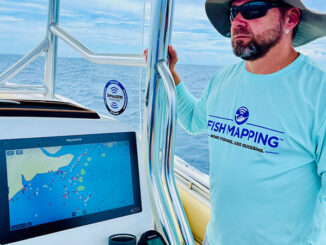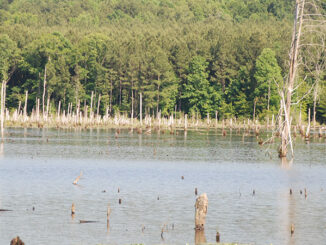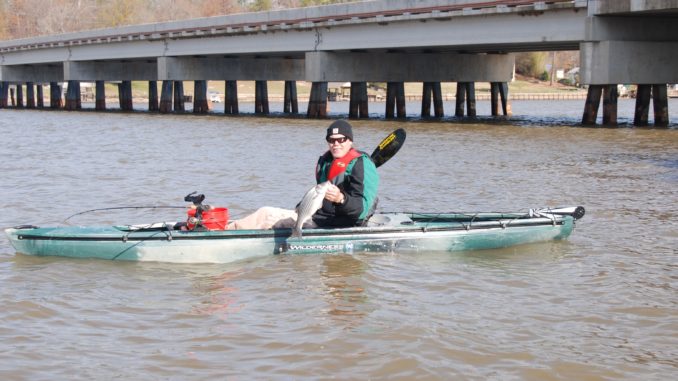
Baitfish, predators will flock to warmer water
Sage advice for kayak anglers looking for fish during the heat of summer is to look for cooler water inflows — creeks, underwater springs, ditches with rain runoff, that sort of thing. The cooler water draws fish.
The same scenario works during the dead of winter, too, only in reverse. When the water temperature of an entire body of water is in the mid to low 40s, fish become relatively dormant. Find an area where the water is just a few degrees warmer, and you’re likely to find a hot spot. Find an area that’s 10 degrees or more warmer, and you’ve found a power-plant discharge.
Artificially heated water manifests itself in a number of ways. The most common is a public energy plant, maybe a nuclear power station or simply a coal fired station where steam is used to create energy. The resulting hot water is cycled into a reservoir.
Warm water attracts baitfish, which attracts gamefish
Industrial warm-water discharge areas are well-known fish producers. Especially during the winter when the surrounding water is seasonably cold. The warm water first attracts photoplankton and then baitfish and on down the line predator fish like bass, catfish, crappie, stripers and a host of others.
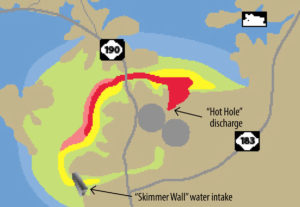 Warm-water discharge areas may all have similar characteristics. At the source of the discharge, the water may be released into a canal or other area to help cool it down before dispersing into the main body of water. The discharge area may even be gated off from public access for security or safety reasons.
Warm-water discharge areas may all have similar characteristics. At the source of the discharge, the water may be released into a canal or other area to help cool it down before dispersing into the main body of water. The discharge area may even be gated off from public access for security or safety reasons.
Another common characteristic is that warm-water discharges have current as the water is pumped back into the lake.
While many anglers flock to the source of the warm water and current, seasoned anglers know larger fish hang back downcurrent, away from the entry point. That’s how they got to be large fish.
Kayak anglers can take advantage of warm-water discharge areas if access is somewhat limited — so long as it’s legal — by using public road right-of-ways to dump in and fish. Typically, if this area is permissible to fish from land, it’s also permissible to use as a dump-in area.
Because baitfish tend to flock to warm-water discharge areas, kayak anglers tend to focus their on lures that imitate baitfish. Crankbaits, soft plastics and live bait all work well in these areas, but so do other baits because the attraction is not all about baitfish, but warmer water in general, which affects all aquatic life.
Close enough for comfort
Kal Summers of Easley, S.C., learned one of his most-valuable winter fishing lessons in the area around the Duke Energy Nuclear Power plant on South Carolina’s Lake Keowee. He knew the area around the discharge as “The Hot Hole”, where large numbers of spotted bass moved into the area to feed on baitfish.
The downside to kayak-fishing is competition from powerboat anglers who have an advantage when trying to position in the swift current. After catching a few 12- to 14-inch spots, Summers let his kayak drift. He worked the bottom with a drop-shot rig.
After drifting out of the area toward the SC183 bridge, he noticed on his depth finder that the water temperatures dropped out of the 70-degree range quickly. But it was well above the mid-40s that was common elsewhere in the lake. He paddled over and immediately began marking fish on the graph.
“I put the drop-shot back down, expecting to catch a pound- and-a-quarter spotted bass and hooked into a 4-pound largemouth,” he said. “I switched over to a deep-diving crankbait and worked the riprap area and caught another almost 3-pound largemouth and a big spot that I lost at the boat.”
Summers caught largemouths, spots, crappie and even a 14-pound blue catfish by working the area with different baits.
“It was like a perfect prespawn pattern,” he said. “The water was still in the upper 50s. It made me think of prespawn fishing, and the fish must have been thinking the same thing.”
What was his takeaway from that day on the lake?
“Let the crowds have the discharge area,” he said. “Right around the corner, I still had decent current that made boat control manageable, and the fish behaved just like they would in pre-spawn.”
February’s best fishing bets
North Carolina
- What — Hybrid striped (Bodie) bass
- Where — Lake Norman
- How — Hybrids can be found in large numbers near the warm-water discharge areas at the lake’s two Duke Energy power station. Cast anything that mimics a shad. The faster and noisier the bait, the better.
- Launch — The closest public ramp to Duke Energy’s Marshall coal-fired power station is at Hager Creek, but there are closer dump-in areas. The closest public ramp to the McGuire nuclear station is at Beatties Ford, but again, there are closer dump-in areas.
- Insider tip — Hybrids will devour large 2- to 3-inch shiners trailed behind your kayak while you cast for schooling fish.
South Carolina
- What — Spotted Bass
- Where — Lake Keowee
- How — The warm-water discharge at the Oconee Nuclear Power station accumulates a lot of bait and a lot of spotted bass in February. Cast surface lures early in the morning and deep-diving crankbaits during the day.
- Launch — Warpath Landing in Pickens County off SC 183 is a just across the lake from the warm water discharge
- Insider tip — The discharge and intake make for a circular flow of warm water in the area of the nuclear plant. The bridge pilings at SC 183 often produce better quality fish than the discharge area.
New Products
-
Lightning Kayaks’ Strike
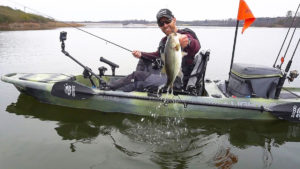
The invention of pedal-drive kayaks has made paddlesports easier, more efficient and accessible to anyone. Lightning Kayaks has gone a step further, building a do-it-all, pedal-drive kayak without a sticker-shock price tag. Meet the new Strike.
The beauty of pedal-drive kayaks is their ease of use. Anyone can hop in the Strike and begin your next adventure. The drive simply drops into a pair of secure drive locks, and with a push of the feet, the fins move side-to-side and propel you forward.
Steering is as easy as a flick of the wrist. The rudder drops down when a pull cord in the cockpit is released, and moving the steering lever left or right turns the boat.
The Strike features a large, rear tankwell and two hatches, giving you plenty of storage for a picnic or an overnight camping trip.
The integrated tracks allow you to mount any accessory, from rod holders to camera booms to parking your phone or tablet.
MSRP is $1,399 to $1,749.
More info at www.indiegogo.com.
- Lew’s SuperDuty 300 Speed Spool baitcast reel series
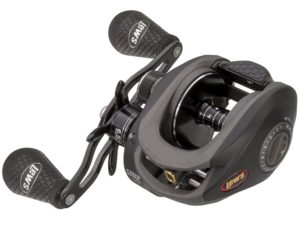
The Super Duty 300 is a great reel for big-bait, heavy line, big-fish situations. It is a supersized version of the original Super Duty, with increased line capacity and overall brute strength. The 300 was made for fishing 8- to 10-inch swimbaits for heavy bass, and other situations involving hard-fishing freshwater fish.
Features include:
- One-piece aluminum frame and handle sideplate;
- Seven stainless-steel, double-shielded ball bearings;
- Zero Reverse® one-way clutch bearing;
- ZRXtra system backup multi-stop gear;
- Machined, double anodized, deep capacity spool;
- High strength solid brass Speed Gears™;
- Double-anodized aluminum spool tension adjustment with audible click;
- Rugged, carbon-fiber drag system;
- Combat Grip thumb bar.
MSRP is $199.99.
More info at www.lews.com.
Click here for info on fishing during winter warming trends.

